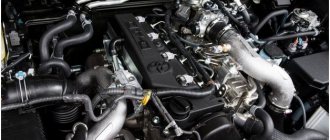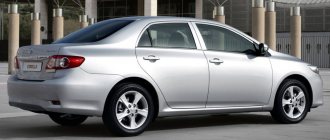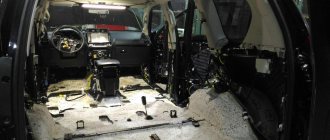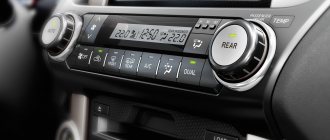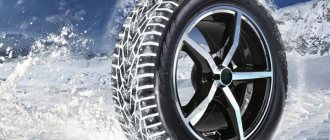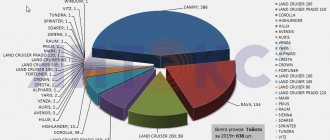As is known, both the fairway and the duration of its voyage depend on the name of the boat. Therefore, people think about the name of a model, and even more so when it comes to the pillars of automakers, for years. Moreover, the world's leading experts in the field of naming are involved for these purposes. The Japanese car Toyota Land Cruiser Prado has been in wide demand for more than 30 years, which speaks not only of the reliability of the SUV, but also of the correct choice of the model name to match its appearance and dynamic characteristics.
What does "Prado" mean?
As is known, both the fairway and the duration of its voyage depend on the name of the boat. Therefore, people think about the name of a model, and even more so when it comes to the pillars of automakers, for years. Moreover, the world's leading experts in the field of naming are involved for these purposes. The Japanese car Toyota Land Cruiser Prado has been in wide demand for more than 30 years, which speaks not only of the reliability of the SUV, but also of the correct choice of the model name to match its appearance and dynamic characteristics.
Toyota Land Cruiser: 20 and 40 series
In 1955, the second generation of cars was introduced. External changes were minor, but thanks to the changes inside, the SUV could safely claim to be used not only by the military, but also by ordinary people.
The first Land Cruiser 40 model appeared on the markets in 1960. The main change was the addition of a transfer case.
How it all started: a little history
Toyota Land Cruiser Prado is considered a mid-size SUV on a frame basis. The first generation rolled off the assembly line in 1987. The model was immediately loved for its high cross-country ability, while inside it was still as comfortable as in a luxury sedan.
“Pradik,” as the SUV is sometimes jokingly called by connoisseurs of this version of Toyota, is produced in two types of bodies:
The second generation began to be assembled on the Toyota Hilux Surf platform. And the third generation has undergone significant transformations, not only in the interior, but also in the name. From this version, Prado is also produced under the Lexus GX label.
Reference! 11 years ago, at the Frankfurt Motor Show, the Japanese showed the fourth version of the Land Cruiser Prado family - 150. Like previous series, cars were imported to Europe exclusively under the Land Cruiser label.
In Russia, Prado began to be officially sold in 1994. Then it was the first generation of such 4x4 vehicles. However, after 2 years the model was updated to the second generation. In those days, the car became the main competitor of the Mitsubishi Pajero. Moreover, the update turned the Toyota Land Cruiser Prado into the first car with independent suspension on the front axle.
In 1999, the SUV slightly changed its appearance due to restyling. The designers increased the safety of the car, increased the number of electronic systems and assistants, and a year later introduced the new 1KD-FTV diesel engine.
The third generation, like its predecessor, is also built on the Toyota 4Runner (or Toyota Hilux Surf) platform. The five-door Prado 120 series already came with three rows of seats. In 2009, production of this series was closed.
The fourth generation, with the body designation J150, went into production in the fall of 2009. Everything was presented to the general public at the same motor show in Frankfurt. The car was delivered to the European part of the world under the Land Cruiser label.
The Land Cruiser Prado 150 modernized the 120 series platform, but retained the wheelbase of 2790 mm. The body was made more massive, which gave the “Japanese” an aggressive appearance.
Interesting fact! The lion's share of the market belongs to the five-door versions of the Prado. In some countries there are seven-seat options. In 2012, production of this model began in Russia in Vladivostok, but it was discontinued in 2014. In 2013, the SUV underwent interior modifications.
The “Japanese” competes with Volkswagen Touareg, Range Rover, Nissan Patrol, Mitsubishi Pajero, Mercedes Gelentvagen and others. The Toyota Land Cruiser Prado is equipped with three types of power units:
Despite the rather high fuel consumption, car owners share positive reviews regarding cross-country ability, smooth ride even on dirt roads and a high level of interior comfort.
Prado fabric - photo, composition, varieties
Let's consider the main types of material, their characteristics and features:
- Blouse or dress fabric. Pleasant upon tactile contact with the skin, silky, soft. The material is able to drape well, does not wrinkle, is velvety on the front side, and has a noble, matte shine.
- Prado suit fabric. The characteristics are similar. The difference is that there is a front side on both sides.
- Velor upholstery material. The most presentable, expensive fabric. It is durable and dense. The front side is covered with thick velvety pile. The canvases retain their shape perfectly, have a high level of wear resistance, and do not lose color when exposed to sunlight or artificial light. Up to thirty percent polyester has been added to the composition.
- Classic option. Density is average, as is weight. The shape is well maintained. Contains polyester and viscose fibers, up to forty percent silk added.
- Interior fabric. Soft, dense material, the front surface is covered with a pleasant-to-touch pile. Ideal for creating fashionable interior solutions. The fabric makes luxurious curtains, drapes, and lambrequins.
What does "Prado" mean?
In order to understand what Land Cruiser Prado means, it is better to look at each word separately. “Land” translated from German means “edge”, “country”. The English language interprets this definition more broadly: “world”, “continent”, “land”.
The concept of “cruiser” is interpreted approximately the same in most world languages. In France it is a “yacht”, in Italy it is a “ship”, in English it is a “cruiser”, and often a “space shuttle”. Sometimes "cruiser" means "traveler".
Attention! The word "Prado" has a deeper meaning and refers to the Spanish language. In the Castilian dialect it means “park”, “field”, “lawn”. This word also means “a place where festivals are held.” The word “Prado” can also be associated with Prada clothing, the production of which also originates in Spain.
Thus, the car can be described as “a traveling cruiser in a clearing.” However, given the variety of interpretations of each word, anyone can combine them into one phrase, limited only by their imagination. In this case, all names will be relatively correct.
Source
Museum collections
The museum's collection contains some of the most complete collections of Bosch, Velazquez, Goya, Murillo, Zurbaran and El Greco.
The works in the halls of Italian painting date from the early Renaissance (Fra Angelico, Mantegna, Botticelli) to the 18th century (Tiepolo). On the 1st floor, the main focus of the exhibition is Raphael's paintings. Paintings by Caravaggio and Gentileschi are located on the ground floor. The works of artists of the Venetian school - Titian, Tintoretto, Veronese and Bassano - form one of the most rich painting ensembles of the Prado.
Many paintings by Italian masters were acquired by kings Charles V, Philip II and especially Philip IV. Paintings by artists from Venice were especially purchased.
- Sandro Botticelli
History of Nastagio degli Onesti1483
- Rafael Santi
Portrait of a Cardinal1510—1511
- Andrea del Sarto
Madonna and Child with an Angel1520-1530
- Titian
Danae1554
Flemish Art
It is no coincidence that the works of Flemish artists ended up in the museum’s collection - for more than a century and a half, the provinces of modern Belgium, the Netherlands and Luxembourg belonged to the Spanish crown. For this reason, many Flemish artists worked in Spain. Paintings by Flemish primitivists - Weyden, Bouts, Memling, Bosch and other 16th-century artists are exhibited on the ground floor. One of the main masterpieces of the Flemish school in the museum is Bosch’s painting “The Hay Wain”. On the ground floor you can see a magnificent collection of Flemish paintings of the 17th century - works by Rubens, Van Dyck, Bruegel and other authors.
- Joachim Patinir
Crossing the River Styx1515
- Hieronymus Bosch
Cart of hay1550
- Pieter Bruegel the Elder
Triumph of Death1560
- Rubens
Three Graces around 1635
Spanish Art
Spanish painting is most widely represented in the museum. Following a chronological criterion, the Prado offers visitors works from various eras: from Romanesque wall painting of the 12th century to the work of Goya in the first third of the 19th century. The museum displays medieval frescoes, Gothic, Renaissance art and realistic paintings from the 19th century. On the ground floor there is painting from the Middle Ages and the Renaissance. On the ground floor there is an exhibition of paintings by El Greco, Velazquez, Ribera, Murillo, Zurbaran and other artists of the Golden Age. The ensemble of Spanish painting in the Prado is crowned with the works of Goya, which can be seen on the 0, 1 and 2 floors.
- Opinions on the reliability of the Prado 120 diesel engine
- Diego Velazquez
Meninas1656—1657
- Diego Velazquez
Portrait of King Philip IV1634-1635
- El Greco
Knight with hand on chest1570-1578
In addition, the museum has an extensive collection of works by lesser-known Spanish artists. In particular, Eduardo Rosales, Vicente Cutanda and others.
German school
The small but outstanding collection of German paintings includes works created between the 16th and 18th centuries. One of the halls on the 0th floor is dedicated to the masterpieces of Albrecht Durer and Lucas Cranach. On the 2nd floor are paintings by Anton Raphael Mengs in the neoclassical style.
English School
Currently, the museum houses a remarkable collection of portraits from the 18th century - the era of England's cultural heyday - and the 19th century. On the ground floor there is a collection of paintings by Gainsborough, Reynolds and Lawrence.
French school
The close relationship between Spain and France in the 17th century, as well as the acquisition of works of art by the Spanish kings Philip IV and Philip V, formed the basis of the Prado's collection of French paintings. On the 1st floor there are paintings by Poussin and Lorrain.
Drawings and prints
The museum has about 4,000 drawings, among which stands out the largest collection of drawings and prints by Goya, including 500 works by the artist. Drawings and engravings from the Prado collections are periodically shown at museum exhibitions.
Sculpture
“The Sacrifice of Orestes and Pylades” is an example of ancient art in the Prado collection
More than 220 classical sculptures brought from Italy in the 16th–19th centuries show the development of this genre from the Archaic period to the Hellenistic and Roman eras. The collection is complemented by works by sculptors Leon, commissioned by Charles V and Philip II in the 16th century.
decorative arts
In the halls of the museum there are tables and consoles from the 16th-18th centuries, cassones, desks, ceramics from Urbino and small sculptures. The largest collection, the Dauphin's Treasure, includes precious objects inherited by Philip V from his father, the Grand Dauphin. Treasures can be seen in the halls of the museum's basement.
What does the word “Prado” mean in the name of the Land Cruiser SUV?
A car is a calling card that characterizes the temperament and character of its owner. The high class of the car indicates the high status of the car owner. The name of the car can also say a lot. Manufacturers, when coming up with the original name of a particular model, put a certain meaning into it.
Toyota Land Cruiser and Prado are popular SUVs both in the domestic market and around the world. Manufacturers have invested a deep, meaningful meaning into the names of models, reflecting the character of the car. Therefore, before purchasing, it is useful to ask how Land Cruiser is translated or what Prado means.
Land Cruiser Review
TLK is a popular Japanese car, the production of which has been established for 60 years. It is based on a powerful frame structure, as well as a suspension: independent at the front, dependent at the rear.
According to owner reviews, the car is characterized by increased comfort, a high level of reliability and cross-country ability in any road conditions. Taken together, these characteristics have made the SUV popular among car enthusiasts.
Among the competing Land Cruiser models are Range Rover, Nissan Patrol and others. The Lexus concern has released a car that is similar in appearance to the Kruzak.
The Toyota Land Cruiser SUV is equipped with three types of engines:
The 4.0-liter engine has maximum speed parameters, starting from a stop in just 8.8 seconds.
Accordingly, the model is characterized by increased fuel consumption.
Prado: brief description
Toyota Land Cruiser Prado is a mini copy of the Toyota Land Cruiser SUV. The car is able to fully compete with Mitsubishi Pajero, Honda Pilot and Volkswagen Touareg. Based on the SUV, the Lexus model is produced, which is similar in appearance to the Prado.
According to reviews from owners, the SUV is characterized by good cross-country ability, soft suspension, increased comfort, and efficiency.
Among the Prado engines, the following stand out:
The diesel Toyota Prado is characterized by economical fuel consumption and excellent speed characteristics. The SUV's gas tank holds 93 liters of fuel, but if necessary, it can be expanded by 45 liters at an additional cost.
Meaning of names
To understand what Land Cruiser Prado means, let’s look at each word separately. Translated from German, land is a country, region. In English, Land has a broader interpretation. It stands for country, world, continent. Used in the meanings of achieve, land, win and many others.
But despite the wide range of meanings, in the classical version it is customary to understand land as a geographical object with boundaries.
The word "cruiser" is used in many languages with identical meanings. The French understand a cruiser as a yacht, the Italians mean a pleasure boat. From English the word is translated as cruiser, sometimes as spaceship. This is also what travelers are called.
It remains to figure out what this word means - Prado. I was able to find it only in the Spanish dictionary. Prado translates as lawn, clearing, park. In another sense, Prado means a place where festivals are held.
Based on a detailed analysis of each word, you can decipher how Land Cruiser Prado is translated into Russian. Using your imagination, the name of the SUV can be interpreted as “a yacht traveling around the world”, “a spaceship on the lawn”.
Source
Everyone wears Prado. All the pros and cons of Toyota Land Cruiser Prado: detailed test
Archaic? There is such a thing. Old-fashioned - yeah, his looks really are not for everyone. Expensive? Can not argue. But all this does not prevent the Toyota Land Cruiser Prado from remaining the best-selling car in its class and the third best-selling among Toyota models in Russia, second only to the Camry and RAV4. Why, even the UAZ Patriot, which costs several times less, was sold out in 2021 one and a half times worse than the Japanese SUV.
* Insurance and tax are calculated for a driver over 22 years old and with more than 4 years of experience, living in Moscow. The value of the KBM for calculating the MTPL policy is 1
There are several reasons for success and all of them have long been known: the magic of the brand, a simple and fairly reliable design with a frame and real all-wheel drive, an omnivorous suspension... On the other hand, Prado is a car that has been produced without any special changes for almost 18 years! Yes, during this time its appearance was updated several times, the interior was freshened and the set of engines changed, but in essence it is still the same car that appeared at the beginning of the two thousandth! And which in expensive trim levels costs almost the same as, for example, the premium Cadillac XT6.
To understand why exactly in the case of the Toyota Land Cruiser Prado they ask for so much money and why buyers part with such amounts with a smile of happiness on their faces, we will use the example of an SUV in the Luxury Safety package with a 2.8 diesel engine, which at the time of the test cost 4 million 492 thousand rubles
.
Interior
There are two options: you will either really like the interior of the LC Prado, or you will go looking for a car from competitors. Over the course of life, the interior of the Prado became more complex both visually and functionally, so today there is a real Babylon of finishing materials of different textures and shades. There is metal-look plastic, there is glossy plastic, and there is also traditional black, with different textures and softness. And there is also “wood” - where would Toyota be without it, laying claim to the wallets of wealthy Russians.
There’s no fault with the build quality - everything fits as it should, doesn’t rattle or creak, and there’s a feeling that everything will remain the same after 5 or 10 years. Although it will take some time to get used to the ergonomics and dozens of buttons, keys and knobs .
Prado fabric - how to care for products
Any model made from Prado group materials requires some care. When choosing a technique, it is important to consider the composition of the tissue. For viscose fibers, careful handling is extremely important. It is necessary to work with the fabric before cutting to avoid shrinkage. When the canvas is wet, its shape deteriorates much faster. If the composition contains a certain percentage of silk threads, you should work with the fabric with the utmost care. Let's consider the basic rules for caring for Prado materials:
- Before you start washing, all items should be sorted according to color scheme.
- The use of bleaches and powder enhancers is prohibited.
- The maximum temperature level is forty degrees.
- Washing on a machine is allowed if the mode is delicate, or by hand.
- Spin use is prohibited.
- You need to dry the products by first laying them on the surface, avoiding exposure to sunlight.
- Upholstered furniture should be dry cleaned if the upholstery is heavily soiled.
- When ironing clothes, use the silk mode, ironing only from the inside of the item.
- The use of steaming is excluded.
- Upholstery materials are cleaned dry. The material is not afraid of the sun, so furniture can be placed near windows and balconies.
Practicality
Due to the design features, frame cars usually do not impress with their capacity and practicality, but the Toyota Land Cruiser Prado cannot be called cramped either. There is enough space in the second row and the trunk is large. You can even order a seven-seat cabin configuration - and the third-row seats will be hidden underground, and not raised along the sides, like in the LC 200. However, if you drive with seven of you, there will be practically no space left for luggage.
Prada fabric - advantages and disadvantages
creativecommons.org
The main advantages of Prado group materials:
- Wear resistance, resistance to minor mechanical damage.
- The material practically does not become electrified when worn.
- The fabric is convenient for cutting and sewing various products.
- It does not cause allergic reactions or skin irritations.
- Matter is hygroscopic.
- All types of materials are pleasant and soft to the touch.
- The fabrics hold their shape and are dense.
- The color is durable, does not fade in the sun, and does not fade when washed.
There are also some disadvantages of the material that need to be taken into account when working with it. If the fabric is wet or damp, it becomes warped very easily. In order for the products to last a long time, it is necessary to follow all the rules for caring for the material. One of them is to avoid contact with anything sharp: scissors, hooks, clamps, snakes, etc. Clues appear on the surface very quickly. If the material contains viscose in large quantities, the fabric may wrinkle. To avoid this problem, manufacturers often add some polyester. This allows you to reduce the percentage of shrinkage and avoid deformation.
Technology and reliability
The basic design of the LC Prado has not changed since the beginning of the 2000s: a frame, a continuous rear axle (thanks for the fact that it is not on springs), all-wheel drive with a low range and two locks - central and rear differentials. The modern Prado has permanent all-wheel drive, with a Torsen center differential, which can be forcibly locked. In normal conditions, the torque is distributed in a ratio of 40:60 percent of traction in favor of the rear axle.
The range of power plants has also changed many times over the years, and the modern LC Prado (until the autumn restyling of 2021) is equipped with three engines to choose from. The base one is a 2.7-liter engine, which produces 163 horsepower and can be equipped with either a five-speed manual (this is the most affordable Prado option for 2.65 million rubles) or a six-speed automatic. The same gearbox is used for all other power plant options: a four-liter with a capacity of 249 horsepower, as well as a 2.8-liter turbodiesel, which has 4 cylinders and only 177 horsepower, but 450 Nm of torque. However, an updated Prado with an upgraded diesel engine of the same volume, which already produces 200 hp, is about to go on sale. — and we will definitely tell you about it separately.
Interestingly, a rear differential lock is not available with the base engine, and the most advanced “technical” options generally appear only in expensive trim levels. We are talking about the Multi Terrain Select system for selecting off-road driving modes, and about the “creeping” cruise control, and about the KDSS stabilizer stiffness control system, and about adaptive shock absorbers with rear air suspension. Fans of older generations of Prado consider all these pieces of hardware to be unnecessary pampering, but it is with them that the SUV turns out to be universal on any roads in any region of Russia. And they do not raise serious questions regarding reliability.
The KDSS hydraulic circuit requires regular oil changes (every 40–60 thousand) and valve checking. The rear air springs are well protected from dirt and easily last 150–200 thousand kilometers, but they do not really like frequent off-road trips and regular overloads. Otherwise, the suspension is reliable and does not require serious repairs for runs of up to 150 thousand kilometers (we do not take into account small consumables that change every 50–60 thousand kilometers).
The secret to the reliability of Toyota cars is generally very simple - frequent and regular maintenance of all important components. Flagship 4.0 engines in good hands can travel up to 400 thousand kilometers without major repairs, requiring only a one-time timing chain change. The basic 2.7 petrol engine is also not bad, but its endurance directly depends on the operating mode. If you drive calmly, you can go three to four hundred thousand kilometers without serious problems. And if you squeeze all the juices out of it, then the problem-free mileage will be reduced by one and a half to two times.
The most capricious was the 2.8 diesel, whose injectors are sensitive to fuel quality. Many owners also turn off the EGR valve and reprogram the control unit, but if you regularly clean it of carbon deposits, it does not cause any special problems.
In general, LC Prado transmissions are also problem-free - of course, provided they are regularly serviced with an oil change. The transfer case and locks are reliable, but on vehicles often used off-road, shocks may occur when turned on. Therefore, when buying a used car, be sure to check the functionality of all components and systems.
Looking at this almost five-meter SUV, you involuntarily expect that it will ride like a barge, swaying on the waves and requiring confident steering input in turns. This is partly true. The modern LC Prado is a soft, supple and very comfortable car. And comfort here, first of all, is driving comfort: the Prado’s suspension does not notice small irregularities at all, only slightly sways passengers on larger bumps, and does not break even in those holes in which a regular crossover would leave a couple of wheels. But! With all this, the Prado turns out to be a very pleasant car not only for passengers, but also for the driver. It’s just that this “pleasure” is not in the exciting chassis or refined handling, but in some special ease that turns any trip into a completely ordinary event and does not require any effort. Neither emotional nor physical: I just sat down and drove there.
The power steering is completely uninformative, but not completely “empty” in terms of effort. The car's reactions are smooth, but not lazy. It’s just that in every turn the driver feels how the car first selects the slips of the high tires, and then stands on the arc and then confidently holds it, without requiring adjustments. And the rolls, even taking into account the high center of mass and impressive dimensions, are not scary - with the Land Cruiser 200, in this sense, everything is noticeably worse, despite the complex hydropneumatic suspension. Active stabilizers on the Prado do their job better, and do not require any driver intervention at all - their stiffness changes automatically based on road conditions. The driver can only choose from the basic driving modes Comfort, Normal or Sport/Sport+. They seem to change not only the response to the gas pedal, but also the stiffness of the AVS adaptive shock absorbers, but. I didn't notice much difference in comfort.
Yes, in sport mode the accelerator becomes much sharper, and the reactions of the power plant become more twitchy, but on uneven roads the Prado drove smoothly and roundly, and continues to drive in any of the settings. The only thing the suspension doesn't like is speed bumps: when the car is empty, the unloaded rear axle bounces unpleasantly. But once you seat a full cabin of passengers and load a few shopping bags into the trunk, everything gets much better.
The simplest basic suspension without a roll suppression system will be even softer and more comfortable, but you can only get it in trim levels no higher than average - in expensive ones you won’t be able to refuse active stabilizers.
The pre-styling 2.8-liter turbodiesel sets the driver up for a measured pace. In the city it is quite enough to easily keep up even in fast traffic, but nothing more - after 80 kilometers per hour the dynamics noticeably fade. The Prado holds cruising speeds of 100–120 kilometers per hour without straining – the tachometer will show less than 2000 revolutions, and the consumption will be within a pleasant 8–9 liters. Taking into account the city and not too serious summer traffic jams, the average figure turned out to be a little more than 13 liters, which is also not bad for a heavy frame SUV.
The 2.7 petrol engine, according to reviews from colleagues, is suitable only for the most phlegmatic drivers, and the most lively is the four-liter “six”. But it will also be the most voracious: fuel consumption among real owners rarely falls below 15 liters per hundred kilometers. That's why I vote for diesel: quiet (by the standards of diesel engines), flexible, with a pleasant reserve of traction and low consumption - just what you need for short and long trips. Yes, driving for many hundreds of kilometers will require some getting used to: the LC Prado does not hold the high-speed straight line very accurately (thanks to the soft tires, pliable suspension and high body). But he will not care at all what is under the wheels - the smooth asphalt of the nearest Moscow region or the broken directions of the Russian outback.
What else should I add? Noise insulation is decent: at a city pace, only diesel rumble can be heard in the cabin, but somehow it is not annoying. On the highway, the sound of the engine is replaced by aerodynamic noise from the huge (and, by the way, very comfortable) side mirrors, but at the speeds allowed in Russia you soon stop paying attention to it. Tires? No, we haven't heard.
Prado fabric - where it is used, photo
There are several areas of application for popular fabric:
- Furniture upholstery. The upholstery fabrics of the Prado series include lightweight materials with a velvety front side. They perfectly complement an elite interior, look expensive and stylish. They look good with the addition of silk, lace, chiffon, and organza.
- Thick upholstery. To create dense upholstery, material with one front side is used. It is predominantly heavy, but pleasant to the touch. The main producers are South Korea and Italy.
- Suit and dress fabric. Depending on the composition, there are several types of canvases. This determines how the clothes will be worn and whether they will wrinkle.
- Elastane fibers. An excellent option for sewing dresses and sundresses. It fits the body well, stretches, does not lose shape, and is not deformable. Some materials contain inclusions of silk fibers. This improves thermoregulation, but makes the canvas sensitive to sunlight.
- Blouse textiles. It allows air to pass through perfectly, the fabric allows the skin to breathe in hot weather, and even at low density it is not see-through. Great for sewing summer outfits - blouses, shirts, T-shirts.
- Pajama sheets. Prado fabrics make excellent, comfortable pajamas and nightgowns. They are pleasant to the body, do not hinder movement and do not trap hot air.
Clothes and dresses from photos: how to find them on the Internet, recommendations
Angelina Jolie's dress in the movie "The Tourist": what it looks like, how to sew, photo
Equipment
This material is being published on the eve of the start of sales of the updated LC Prado, so the price block had to be redone at the last moment. So, the base Prado has a 2.7-liter naturally aspirated engine with 163 hp. and a manual transmission, as before, is estimated at 2.656 million rubles
. For this money, the buyer will receive a car on steel wheels with halogen headlights, a fabric interior and a plastic steering wheel, air conditioning, mechanically adjustable seats, audio preparation, but with electrically adjustable and heated side mirrors, electric windows and an alarm system. There is no seat heating in this version, and the windshield is heated only in the resting zone of the brushes.
Having paid an additional 230 thousand rubles for the Standard version
, you can get three-zone climate control, alloy wheels, a leather-wrapped steering wheel, electric drives and heated front seats, and for another 100 thousand rubles the Prado will have a six-speed automatic transmission and cruise control.
The next configuration, Comfort, is still 2.7 with an automatic transmission, but almost 600 thousand rubles more expensive (3.563 million rubles)
. For this money, the buyer will receive a tire pressure monitoring system, a rear view camera, a color display on the dashboard, a keyless entry system, a multimedia system with nine speakers, a smart traction control system and assistance systems when climbing or descending.
All other trim levels are available only for the 4.0 petrol engine or the new 2.8 diesel engine. Moreover, if before restyling, a diesel engine was cheaper than a V6 engine, then the new 200-horsepower unit costs exactly 20 thousand more than a gasoline “six” in any equipment. The minimum price for more powerful engines starts from 3.867 million rubles
for the LC Prado 4.0 in the Elegance package, which adds to the SUV LED headlights, high wheels, new body decor with dark lights and “dark chrome” on the radiator grille and window trims, black mirrors and black roof rails, as well as interior trim with inserts "under the tree".
More useful options include electrically adjustable steering wheel, rain sensor, rear differential lock and pre-heater. For an additional 110 thousand, dealers will offer the Elegance Plus
with leather interior trim and a cooled box under the central armrest.
package (4.191 million rubles for a gasoline engine and 4.211 million for a diesel engine)
- these are 4 all-round cameras, a driving mode selector, front seat ventilation, KDSS active stabilizers, a blind spot monitoring system and a Crawl Control complex.
Above are only two new Black Onyx
- essentially renamed Luxury Safety, which differ from the pre-restyling models only in appearance, but not in equipment.
For 4.696 million rubles with a 4.0 engine
(or 20 thousand more expensive with a diesel engine), all of the above adds JBL music with 14 speakers and navigation, AVS adaptive shock absorbers and rear air suspension, an additional Sport+ mode in the driving electronics settings and a package of Toyota Safety Sense safety systems, including adaptive cruise control, a lane marking monitoring system, automatic switching of lights from high to low and a traffic sign recognition camera.
And if someone thinks that for this money it’s already “easier to get,” then I hasten to disappoint - prices for the flagship SUV only start at 5.096 million rubles, and end well over 6 million rubles. Maybe competitors are cheaper?
Source

